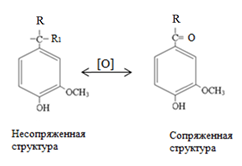CHARACTERISTICS OF THE REDOX STATE OF THE LIGNIN-CARBOHYDRATE WOOD MATRIX AT THE INITIAL STAGES OF DEVELOPMENT ON THE EXAMPLE OF SCOTS PINE
UDC 582.475, 543.421, 54.061
Abstract
The studies of wood formation at the initial stages allowed confirming the determining role of the redox transformations of monolignols in the lignification of plant matrix. The change in the composition of the phenolic fraction (conjugated and non-conjugated phenolic structures) of the phenol-quinone redox system of the cell wall was studied using the derivative and differential UV spectroscopy. It was shown that the accumulation of low-molecular phenolic compounds in the initial period of ontogenesis occurs mainly in the "needles" of plants. It was confirmed that the seedlings being removed to the hardening site adapt to the existing temperature regime. It is characterized by lower content of low-molecular phenolic compounds preventing the development of oxidative processes. The plant is exposed to oxidative stress at low temperatures, when the enzymatic (peroxidase activity) system of plant protection is activated. The change in the coniferyl alcohol content as a marker of the lignification is shown. The correlation of changes in peroxidase activity with the total content of phenolic compounds and coniferyl alcohol was shown. The IR spectroscopy method showed a change in the ratio of carbohydrate and lignin components at the initial stages of the development of seedlings of scots pine.
Downloads
Metrics
References
Bogolitsyn K.G., Lunin V.V., Kosyakov D.S., Karmanov A.P., Skrebets T.E., Popova N.R., Malkov A.V., Gor-bova N.S., Pryakhin A.N., Shkayev A.N., Ivanchenko N.L. Fizicheskaya khimiya lignina. [Physical chemistry of lig-nin]. Moscow, 2010, 492 p. (in Russ.).
Fuksman I.L., Novitskaya L.L., Isidorov V.A., Roshchin V.I. Lesovedeniye, 2005, no. 3, pp. 4–10. (in Russ.).
Freudenberg K. The constitution and biosynthesis of Lignin. Molecular biology, biochemistry and biophysics, New York, 1968, pp. 47–122.
Sakakibara A. Recent advances in lignin biodegradation research, 1983, vol. 1, pp. 12–33.
Tobimatsu Y., Schuetz M. Current Opinion in Biotechnology, 2019, vol. 56, pp. 75–81. DOI: 10.1016/j.copbio.2018.10.001.
Deighton N., Richardson A., Stewart D., McDougall G.J. Holzforschung, 1999, vol. 53, pp. 503–510. DOI: 10.1515/HF.1999.083.
Bao W., O'Malley D.M., Whetten R., Sederoff R.R. Science, 1993, vol. 260, pp. 672–674. DOI: 10.1126/science.260.5108.672.
Sharova Ye.I., Medvedev S.S. Fiziologiya rasteniy, 2017, vol. 64, no. 1, pp. 3–18. DOI: 10.7868/S0015330317010146. (in Russ.).
Zhigunov A.V., Sokolov A.I., Kharitonov V.A. Vyrashchivaniye posadochnogo materiala s zakrytoy kornevoy siste-moy v Ust'yanskom teplichnom komplekse. Prakticheskiye rekomendatsii. [Growing planting material with a closed root system in the Ustyansk greenhouse complex. Practical recommendations]. Petrozavodsk, 2016, 43 p. (in Russ.).
Mattis G.Ya. Vestnik sel'skokhozyaystvennoy nauki, 1978, no. 11, pp. 109–114. (in Russ.).
Kozina L.V. Metabolizm fotoassimilyatov i peredvizheniye veshchestv u khvoynykh. [Metabolism of photoassimilates and movement of substances in conifers]. Vladivostok, 1995, 126 p. (in Russ.).
Nikolayeva T.N., Lapshin P.V., Zagoskina N.V. Khimiya rastitel'nogo syr'ya, 2021, no. 2, pp. 291–299. DOI: 10.14258/jcprm.2021028250. (in Russ.).
Bogolitsyn K.G., Surso M.V., Gusakova M.A., Zubov I.N. IVUZ. Lesnoy zhurnal, 2013, no. 6, pp. 91–96. (in Russ.).
Khviyuzov S.S., Bogolitsyn K.G., Gusakova M.A., Zubov I.N. Fundamental'nyye issledovaniya, 2015, no. 9, pp. 87–90. (in Russ.).
Vartanian E., Barres O., Roque C. Spectrochimica Acta Part A: Molecular and Biomolecular Spectroscopy, 2014, vol. 136, pp. 1255–1259. DOI:10.1016/j.saa.2014.10.011.
Blansey A., Shutyy L. Fenol'nyye soyedineniya rastitel'nogo proiskhozhdeniya. [Phenolic compounds of plant origin]. Moscow, 1977, 297 p. (in Russ.).
Deng Y., Lu S. Critical Reviews in Plant Sciences, 2017, vol. 36, pp. 257–290. DOI: 10.1080/07352689.2017.1402852.
Muro-Villanueva F., Mao X., Chapple C. Current opinion in biotechnology, 2019, vol. 56, pp. 202–208. DOI: 10.1016/J.Copbio.2018.12.008.
Sudachkova N.Ye. Lesovedeniye, 1998, no. 2, pp. 3–9. (in Russ.).
Neugart S., Kläring H.P., Zietz M., Schreiner M., Rohn S., Kroh L.W., Krumbein A. Food Chemistry, 2012, vol. 133, pp. 1456–1465. DOI: 10.1016/j.foodchem.2012.02.034.
Sarkanen K.V., Lyudvig K.Kh. Ligniny (struktura, svoystva, reaktsii). [Lignins (structure, properties, reactions)]. Mos-cow, 1975, 632 p. (in Russ.).
Barros J., Serk H., Granlund I., Pesquet E. Annals of botany, 2015, vol. 7, pp. 1053–1074. DOI: 10.1093/aob/mcv046.
Andreyeva V.A. Ferment peroksidaza. Uchastiye v zashchitnom mekhanizme rasteniy. [Enzyme peroxidase. Participa-tion in the defense mechanism of plants]. Moscow, 1988, 127 p. (in Russ.).
Roitto M., Ahonen-Lonnarth U., Lamppi J., Huttunen S. European Journal of Forest Pathology, 1999, vol. 29, no. 6, pp. 399–410.
Shavnin S.A., Yusupov I.A., Marina N.V., Montile A.A., Golikov D.Yu. Fiziologiya rasteniy, 2021, vol. 68, no. 2, pp. 1–11. DOI: 10.31857/S0015330321020184. (in Russ.).

Copyright (c) 2022 chemistry of plant raw material

This work is licensed under a Creative Commons Attribution 4.0 International License.

This work is licensed under a Creative Commons Attribution 4.0 International License.
The authors, which are published in this journal, agree to the following conditions:
1. Authors retain the copyright to the work and transfer to the journal the right of the first publication along with the work, at the same time licensing it under the terms of the Creative Commons Attribution License, which allows others to distribute this work with the obligatory indication of the authorship of this work and a link to the original publication in this journal .
2. The authors retain the right to enter into separate, additional contractual agreements for the non-exclusive distribution of the version of the work published by this journal (for example, to place it in the university depository or to publish it in a book), with reference to the original publication in this journal.
3. Authors are allowed to post their work on the Internet (for example, in a university repository or on their personal website) before and during the review process of this journal, as this may lead to a productive discussion, as well as more links to this published work.











